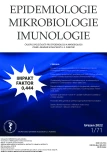Detection of Borrelia miyamotoi in Ixodes ricinus ticks in Southern Moravia – risk for public health
Authors:
R. Kejíková 1,2; I. Rudolf 1,2
Authors‘ workplace:
Ústav biologie obratlovců AV ČR, v. v. i., Brno
1; Ústav experimentální biologie, Přírodovědecká fakulta, Masarykova univerzita, Brno
2
Published in:
Epidemiol. Mikrobiol. Imunol. 71, 2022, č. 1, s. 57-59
Category:
Short Communication
Overview
Borrelia miyamotoi is an emerging tick-borne pathogen. The vector is ticks of the Ixodes ricinus complex, causing relapsing fever- like disease and widespread in the temperate zone of the Northern Hemisphere. The present study documents the prevalence of B. miyamotoi in Ixodes ricinus ticks at four sites of the South Moravian Region. The spirochete B. miyamotoi was detected in a total of 10 samples from all four sites and all instars. The occurrence of B. miyamotoi in ticks in the Czech Republic poses a potential risk to public health.
Keywords:
Ixodes – Ticks – prevalence – relapsing fever – vector – Borrelia
Sources
1. Fukunaga M, Takanashi Y, Tsuruta Y, et al. Genetic and phenotypic analysis of Borrelia miyamotoi sp. nov., isolated from the ixodid tick Ixodes persulcatus, the vector for Lyme disease in Japan. Int J Syst Bacteriol, 1995;45:804−810.
2. Cutler S, Vayssier-Taussat M, Estrada-Peña A, et al. A new Borrelia on the block: Borrelia miyamotoi – a human health risk? Euro Surveill, 2019;24.
3. Platonov AE, Karan LS, Kolyasnikova NM, et al. Humans infected with relapsing fever spirochete Borrelia miyamotoi, Russia. Emerg Infect Dis, 2011;17:1816–1823.
4. Tobudic S, Burgmann H, Stanek G, et al. Human Borrelia miyamotoi Infection, Austria. Emerg Infect Dis, 2020;26:2201−2204.
5. Richter D, Debski A, Hubalek Z, et al. Absence of Lyme disease spirochetes in larval Ixodes ricinus ticks. Vector-Borne Zoonotic Dis, 2011;12:21−27.
6. Honig V, Carolan HE, Vavruskova Z, et al. Broad-range survey of vector-borne pathogens and tick host identification of Ixodes ricinus from Southern Czech Republic. FEMS Microbiol Ecol, 2017;93:1−13.
7. Crowder ChD, Carolan HE, Rounds MA, et al. Prevalence of Borrelia miyamotoi in Ixodes ticks in Europe and the United States. Emerg Infect Dis, 2014;20:1678–1682.
8. Rosický B, Černý V, Daniel M, et al. Roztoči a klíšťata škodící zdraví člověka. Praha: Academia; 1979. s. 37−50.
9. Szekeres S, Coipan EC, Rigo K, et al. Eco-epidemiology of Borrelia miyamotoi and Lyme borreliosis spirochetes in a popular hunting and recreational forest area in Hungary. Parasit Vectors, 2015;8:309.
10. Janeček J, Nováková M, Oppelt J, et al. Complete chromosomal sequences of two Borrelia miyamotoi samples obtained from Ixodes ricinus eggs in Czechia. Microbiol Resour Announc, 2020;9:e01504–19.
11. Rollend L, Fish D, Childs JE. Transovarial transmission of Borrelia spirochetes by Ixodes scapularis: a summary of the literature and recent observations. Ticks Tick-Borne Dis, 2013;4:46−51.
12. Breuner NE, Dolan MC, Replogle AJ, et al. Transmission of Borrelia miyamotoi sensu lato relapsing fever group spirochetes in relation to duration of attachment by Ixodes scapularis nymphs. Ticks Tick-Borne Dis, 2017;8:677−681.
Labels
Hygiene and epidemiology Medical virology Clinical microbiologyArticle was published in
Epidemiology, Microbiology, Immunology

2022 Issue 1
Most read in this issue
- Next generation probiotics: an overview of the most promising candidates
- Overview of basic epidemiological characteristics and descriptive analysis of the incidence of human yersiniosis in the Czech Republic in 2018–2020
- Decreasing neutralization antibody levels following vaccination against SARS-CoV-2 in the elderly: an observational study in Southern Moravia, Czech Republic
- Characteristics of homeless persons hospitalized in health care facilities in the Czech Republic in 2006–2015
